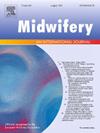城市分娩创伤量表评估产科人员创伤后应激症状的有效性
IF 2.5
3区 医学
Q1 NURSING
引用次数: 0
摘要
每年有29.5万名妇女死于妊娠或分娩并发症,还有更多的妇女和婴儿出现严重并发症。产科工作人员经常接触这些事件,并可能出现创伤后应激症状或障碍(PTSD)。然而,目前还没有专门的工具来识别和评估分娩相关的创伤后应激障碍。为此,本研究采用并验证了城市出生创伤量表(City BiTS)。方法对2016 - 2023年分三波招募的396名产科卫生专业人员进行了城市产科人员问卷调查。参与者报告了他们的创伤性分娩事件的经历,并完成了评估PTSD症状的量表。心理测量分析用于确定内部一致性、因素结构和结构效度。结果超过一半的参与者发生过严重伤害(55.9%)或死亡(41.4%),30.7%的参与者符合PTSD诊断标准(95% CI 26.2 - 35.5)。量表具有良好的内部一致性(α = 0.95)和结构效度。创伤后应激障碍症状与较大的感知创伤(rho 0.37, p < 0.001)和较差的应对能力(-0.30)相关。(p = 0.001),且分娩时产妇或婴儿死亡后症状加重(Mann-Whitney U 18609, p = 0.05)。2因素和3因素结构均得到支持,两种分析均以出生相关症状的主分量表方差最大(53.82%)。其余项目要么被归为一般症状的一个子量表(固定的2因素模型),要么被分为高唤醒和快感缺乏;分离分量表(三因素模型)。结论创伤性分娩对产科人员的心理影响较大。改编后的城市BiTS(产科人员)显示出在这一群体中识别创伤后应激障碍症状的希望,尽管建议进一步完善其因素结构。本文章由计算机程序翻译,如有差异,请以英文原文为准。
Validation of the City Birth Trauma Scale to assess post-traumatic stress symptoms in maternity staff
Background
Each year, 295,000 women die from pregnancy or childbirth complications, with many more women and babies experiencing severe complications. Maternity staff are often exposed to these events and can develop post-traumatic stress symptoms or disorder (PTSD). However, there are currently no tools to specifically identify and assess birth-related PTSD in maternity staff. This study therefore adapted and validated the City Birth Trauma Scale (City BiTS) for this purpose.
Method
The City BiTS (Maternity staff) was completed by 396 maternity health professionals recruited in three waves between 2016 and 2023. Participants reported their experiences with traumatic birth events and completed the scale to assess PTSD symptoms. Psychometric analyses were used to determine internal consistency, factor structure, and construct validity.
Results
Over half of participants had witnessed severe injuries (55.9 %) or deaths (41.4 %), and 30.7 % met PTSD diagnostic criteria (95 % CI 26.2 - 35.5). The scale demonstrated good internal consistency (α = 0.95) and construct validity. PTSD symptoms were associated with greater perceived trauma (rho 0.37, p<.001), poorer coping (-0.30., p<.001), and symptoms were greater after births involving maternal or infant deaths (Mann-Whitney U 18,609, p = .05). Both 2-factor and 3-factor structures were supported, with the main subscale of Birth-related symptoms accounting for most variance (53.82 %) in both analyses. Remaining items either grouped into one subscale of General symptoms (fixed 2-factor model) or split into Hyperarousal and Anhedonia & detachment subscales (3-factor model).
Conclusion
Traumatic births have a significant psychological impact on maternity staff. The adapted City BiTS (Maternity staff) shows promise for identifying PTSD symptoms in this group, though further refinement of its factor structure is recommended.
求助全文
通过发布文献求助,成功后即可免费获取论文全文。
去求助
来源期刊

Midwifery
医学-护理
CiteScore
4.50
自引率
7.40%
发文量
221
审稿时长
13.4 weeks
期刊介绍:
Midwifery publishes the latest peer reviewed international research to inform the safety, quality, outcomes and experiences of pregnancy, birth and maternity care for childbearing women, their babies and families. The journal’s publications support midwives and maternity care providers to explore and develop their knowledge, skills and attitudes informed by best available evidence.
Midwifery provides an international, interdisciplinary forum for the publication, dissemination and discussion of advances in evidence, controversies and current research, and promotes continuing education through publication of systematic and other scholarly reviews and updates. Midwifery articles cover the cultural, clinical, psycho-social, sociological, epidemiological, education, managerial, workforce, organizational and technological areas of practice in preconception, maternal and infant care.
The journal welcomes the highest quality scholarly research that employs rigorous methodology. Midwifery is a leading international journal in midwifery and maternal health with a current impact factor of 1.861 (© Thomson Reuters Journal Citation Reports 2016) and employs a double-blind peer review process.
 求助内容:
求助内容: 应助结果提醒方式:
应助结果提醒方式:


